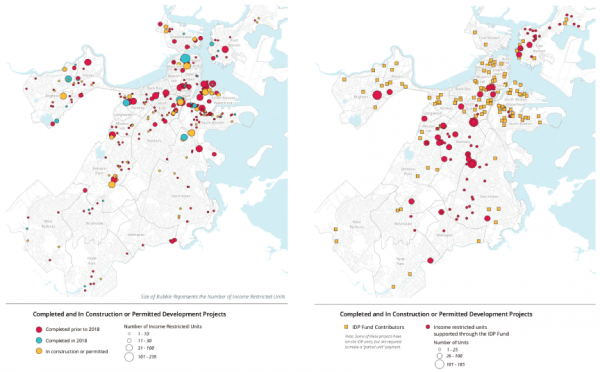March 27, 2019

As the city begins to re-examine its standards for required affordable housing production, a new report on the progress of its Inclusionary Development Policy (IDP) shows a jump in production of units due to the program in the last year.
The 19-year-old policy requires that most new residential developments that need city approvals contribute to affordable housing in some way. Affordable units can be located in their buildings, or built off-site but nearby, or the developers can pay into a city fund that then goes toward building and acquiring more affordable housing, or some combination of the three.
About 21 percent of all IDP units were built in the last year, city officials said at a roundtable discussing the report on Monday. In 2018, 546 inclusionary units were completed and 834 more were under construction or permitted. Housing chief Sheila Dillon said the trend will likely continue into 2019.
The long recovery since 2008 seems to have hit a zenith with an explosion of new construction. Officials say Boston has leveraged the booming private housing market to boost the number of affordable units in the city, but add that there’s a careful balance between hitting affordability standards and shutting down development entirely.
“It’s calibrating it correctly so that we’re not disincentivizing development through too onerous a burden,” said Brian Golden, director of the Boston Planning and Development Agency. “But, at the same time, getting as much as we can out of private development to benefit people who otherwise would not be able to handle market rates when it comes to rentals and home ownership.”
Data show jumps in on-and off-site affordable housing in the same places where construction is booming. About 16 percent of the IDP units have been built downtown, followed by the Seaport District with 13 percent, the report notes.
“In total, 57 percent of IDP Units can be found in central Boston neighborhoods, stretching from the North End to the South End, and from the Seaport to the Fenway,” according to the report.
More than half of the new 2018 units came online from the 239-unit income-restricted Beverly development near North Station. The Treadmark Building in Dorchester is also among the period’s highlights. After a devastating fire just before completion, the mixed-use building was demolished and rebuilt by the end of 2018. Its 83 apartments include 51 income restricted rental units, 28 market rate condominiums, and 4 IDP on-site condos.
Between built, in progress, and permitted units, “you can see that in each of those phases they’re in all neighborhoods of the city,” said Tim Davis, BPDA housing policy manager. “Pretty much with only Mattapan as maybe one area with a lot fewer.”
Mattapan has only 2 percent of completed on- and off-site units and 2 percent of all completed IDP-funded units, according to city data. A scatterplot shows that all Mattapan units were completed prior to 2018, with none in construction or permitted. Dorchester, the city’s largest neighborhood, houses only 5 percent of all on- and off-site units.
Almost 2,600 on- and off-site income restricted units came online since 2000, with 1,414 units built through funding channels, including the IDP pool. Income restricted housing financed by the IDP fund are mostly found in Chinatown (12 percent), Dorchester (12 percent), and Roxbury (27 percent).
Affordable housing advocates in the region have pushed for higher standards of affordability overall and a reduction in the way municipalities determine affordability. About half of Boston residents earned less than $35,000 a year, according to a 2016 report.
The report shows that 34 percent of current owners of IDP units had incomes between $25,000 and $50,000 when they purchased and 50 percent between $50,000 and $75,000. Renters of these units hit lower income levels overall, with 16 percent making less than $25,000, 49 percent between $25,000 and $50,000, and 29 percent between $50,000 and $75,000.
An ongoing project for which IDP funds can be used is the “1,000 Homes” effort, in which the city will purchase 1,000 existing properties and preserve them as income-restricted housing.
Revised in 2015, the program is on the cusp of another reassessment. The advisory firm Landwise will conduct a feasibility study on the city development market to give them some clarity on “what we can extract from developers in different neighborhoods,” Davis said.
Meetings with developers and housing advocates, as well as a series of community meetings starting in the late spring, should lead to a new policy proposal later this year.
“Any change to IDP or linkage will come down to the economics of development here in Boston,” said Sheila Dillon.
Boston has other sources of affordable housing money, such as the Community Preservation Act fund, for which they are working on improving the state match. A hearing Tuesday addressed a home rule petition that would apply IDP standards to all 10-unit-plus buildings in Boston, not just the ones that need zoning relief and trigger the IDP requirements.
The market is “mature,” Golden acknowledges, and a downturn in construction would also lead to a downturn in IDP funds.
“So, people are concerned,” he said. “There is sort of a nervousness that pervades the development environment. We’re sensitive to all of that and, and what informs us going forward as we tweak the program, as we modify the program, is we do not want to do harm to that which we’ve already achieved and continue to achieve. We want a program that is workable and that means workable from the standpoint of City Hall and public policy makers and public regulators, but also workable and in the private development world.”


